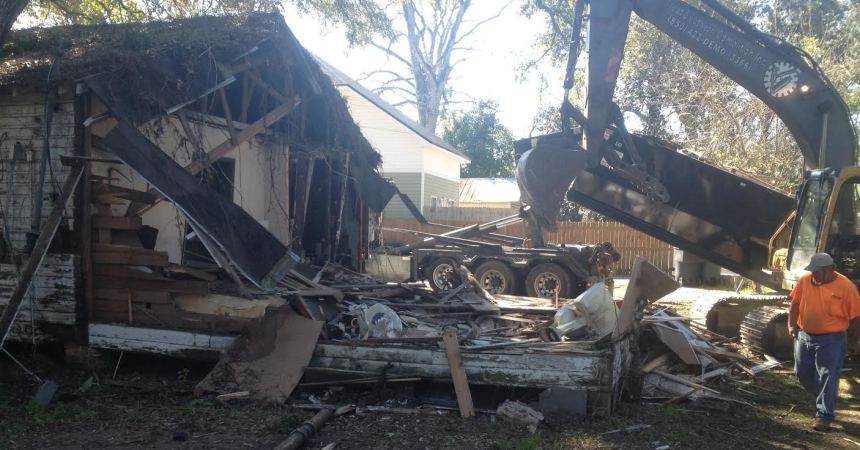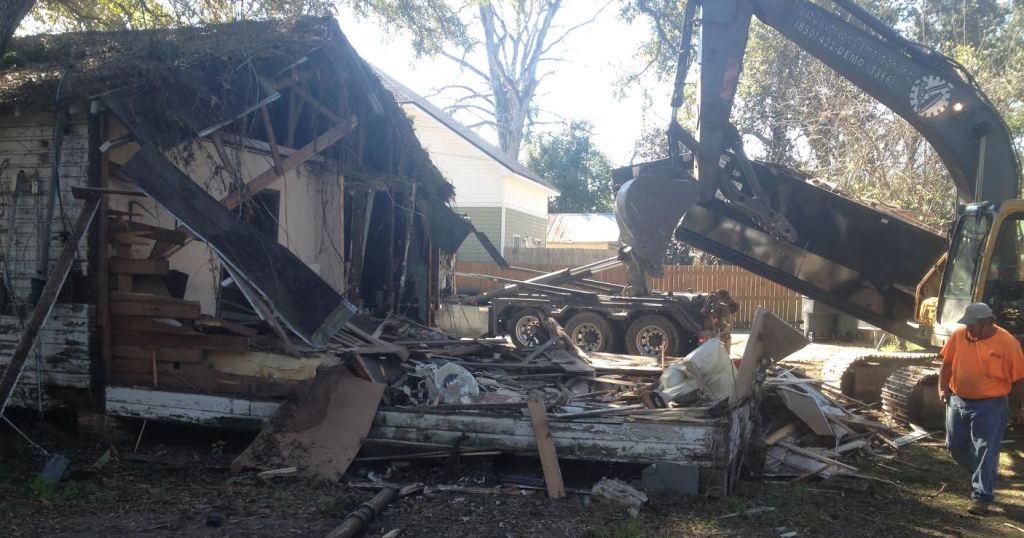
SHINGLES IS NO MORE
[subtitle] Emotional crowd witnesses demolition [/subtitle]
All videos provided by LarryLove/ Lovelarry2379@gmail.com

A demolition team took down the building that was once home of Shingles Chicken House.
Photo by St. Clair Murraine
By St. Clair Murraine Outlook writer
The kitchen section of Shingles Chicken House was almost down, when Larry Lee Morris Jr. rode by on his bicycle Monday morning.
He hurriedly hopped off, dropping the bike to the ground as he grabbed his cell phone and began shooting video of the demolition.
Long tears flowed down his cheeks. He couldn’t believe that the place where he has had several meals was being torn down.
City officials said the building near the intersection of Mills and Miles streets is one of many in the area that will be removed to make room for the extension of FAMU Way. They estimated that by 2020 the project, which is funded from a Blueprint 2000 penny tax, will intersect with Lake Bradford.
The demolition of Shingles marked the final chapter of a business that Henry Shingles started in 1968.
“I cry because I have so many good memories here,” Morris said. “I started a lot of great things here. He (Shingles) helped me start my business.”
Morris, a graphic designer, said he often bartered with Shingles by printing his flyers and menus for food while he was a student at FAMU.
An emotional crowd of several people from the neighborhood near the Mills and Miles intersection watched the building being taken down. Sam and Darryl Shingles, two of the owner’s sons also had a first-hand look.
Even radio disc jockey Joe Bullard stopped by before the demolition began. He had to have one last look at the building still standing.
“It is a loss to the community,” Bullard said. “I say that because when you add it all up and you say seafood, you think of Red Lobster and Seineyards. When you think of chicken you think of Lindy’s or Kentucky Fried Chicken and now Bojangles.
“But Shingles was a one-stop shop; they had it all in one spot.”
Shingles died in 1997, passing the tradition of cooking fried chicken and fish to his children. They maintained the business until the economic downturn of 2007 made it too difficult to continue.
“This is a bitter-sweet situation because I know how hard my father worked; the sweat he has put in to put this area on the map,” Sam Shingles said. “It’s probably a sad day up yonder but we have a lot of memories to hold on to.”
Darryl Shingles recalled how he spent countless hours cooking and cleaning the kitchen.
“There are so many sentimental values coming through here; the memories of (entertainment) artists coming through,” he said. “There is not a day that I go out and people don’t ask of Shingles. Every day.”
Many of the onlookers remembered the place that Shingles opened with a small loan as the spot where they watched television, played card games and listened to music on a jukebox. Shingles also was a frequent stop for celebrities such as R&B singer Betty Wright.
Shingles clientele didn’t take long to develop. Word-of-mouth was sufficient. His mild-mannered demeanor also helped to keep customers coming back.
He was living a childhood dream.
“My mother owned a restaurant at home in Wakulla County and all I wanted was to have my own some day,” Shingles told a reporter more than 15 years ago.
Before the demolition, Autumn Calder, a planning manager with Blueprint 2000 Intergovernmental Agency, led a walk through of the old building. Later, Sam Shingles did the same, digging through scattered papers on the floor.
He found an obituary of a family friend along with a picture of former FAMU baseball coach Costa Kittles.
The old fryers were still in place. A tray of hot sauces sat undisturbed on the counter where orders were taken.
Those couldn’t be saved, but Calder said the history of the building along with several others along the new FAMU Way will have kiosks with written history.
“I love finding the connections between the different African American communities in Tallahassee,” Calder said. “Sometimes we tend to view these different communities as somewhat independent, but once you start digging under the surface you see how inter-connected everything was.
“With Shingles being a place that was known to everybody, it was definitely a place that bridged all the sectors.”







